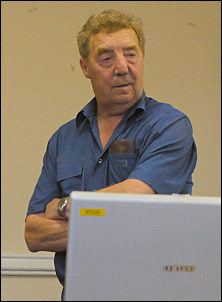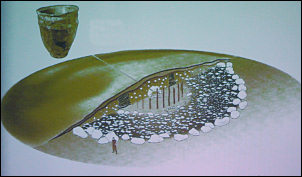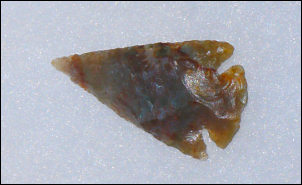|
Tue 08 Jun 2010
John Trippier – Prehistoric Archaeology of the West Pennines |
|
John Trippier –
Prehistoric History of the West Pennines
John, a freelance archaeologist, introduced his illustrated talk
by explaining that he was going to concentrate on the ‘lumps and
bumps’ of the West Pennine moors.
Any object dated before 3,000 BC was described as being from a
period of pre-history. And any object of that age or older and
laid above ground was a pre-historic monument.
John gave us a broad view of time in north west England from the
end of the ice age, Palaeolithic Age (10,000 BC), through to the
Bronze Age (3,000 BC to 500 BC) and what each age represented. |

John Trippier |
|
His main
interest though was in 3 local pre-historic sites, Pikestones,
Round Loaf and Rushy Brow.
He explained that the Lancashire University Archaeology Unit
excavated sites and carried out an extensive survey from
Withnell to Smithills, Bolton. These were carried out in the mid
1980s and were published in the mid 1990s.
John acknowledged other sources that he had used included 2
books from a Chorley author, Gladys Sellers.
Acknowledgement was also given to excavations in the 1950s in
this area by then members of this society. |
|

Excavations at Noon Hill cairn by Chorley Historical and
Archaeological Society c1960 |

An artists impression of what Noon Hill burial cairn may have
looked like. The collared urn would have contained human
remains. |
|

One of John's finds.
A flint arrow head 15mm long |
Particular attention was given to the description of a chambered
long cairn such as the one at Pikestones.
Rushy Brow was a site excavated in the mid 1980s and explained
of the many flints found there.
It was Round Loaf’s history though, which in John’s opinion, was
going to be controversial. He invited suggestions from members
as to what made it. Was it a monument or a natural feature? He
provided an explanation that it could be a glacial feature based
on its size, shape and location.
It was an interesting and thought provoking evening from John,
which was rounded off by a good question and answer session.
P Robinson |
From 1983 to 1985 the Anglezarke Uplands were surveyed by the
Cumbria and Lancashire Archaeological Unit (which became
Lancaster University Archaeological Unit). This is now Oxford
Archaeology North - based in Lancaster. Their report was
published in the Proceedings of the Prehistoric Society 61,
1996, pp. 133-166
John referred to this report in his talk and it makes
fascinating reading. To save you having to track a copy down
there is a pdf (2.9Mg) of it available by
clicking here.
BH. |